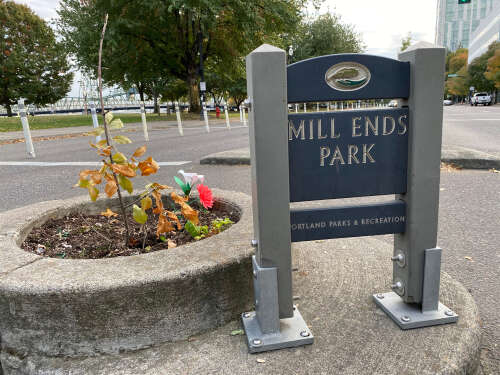
Burntwood Prince’s Park, named for the future Edward VII in honour of his wedding, is certainly quite small: at an area of under 135m², you could fit 10,518 of it into London’s Hyde Park, but is it the world’s smallest park?
Across the road from a church, it contains a single bench and precisely three trees, charmingly (or extremely dangerously if you’re a Richard Dawkins type) named Faith, Hope and Charity. But it is not ‘officially’ recognised as the smallest park in the world: stout-producing fact arbiters Guinness will only concede that it is the smallest in the UK.
The actual smallest park, according to whatever the modern-day version of a McWhirter is, is Mill Ends Park in Portland, Oregon, where it occupies less than a third of a square-metre. But does it count as a park, or is it just a ‘glorified flower pot’, as an angry fan of Prince’s Park lashed out in 2013 while attempting to at least secure the park’s place in international records by making it the site of the world’s shortest fun run: 55 steps, apparently.

What are the important features of a park? Are three trees, a bench and a fence a minimum number of features? Is it enough features, or is Prince’s Park just a green or garden that got over-excited due to 1860s Royal wedding fever?
This definitional problem also affects the upper end of the park scale: if you’re looking for the largest park, do you include vast country parks that are basically just forests? Even if you exclude parks outside of urban areas, you end up with the largest being Chugach State Park in Alaska, which despite being larger than Greater London and containing actual mountains is technically speaking in the city of Anchorage. You’re going to need a hell of a redevelopment plan to try and beat that record.
And, having said all that, is Prince’s Park even the smallest park in the UK? A 2018 study by Ordnance Survey into Britain’s parks claimed the smallest is the Old Town Maritime Gardens in Hastings, at just 32.8m². Okay, it’s a boat with some flower pots in it sitting on some gravel, but can we argue with Ordnance Survey?
Maybe Burntwood can still make the case for its world’s smallest park on the basis of nomenclature – argue that, if you want to be considered a park, you have to have the word park in the name. But even then, they might be stuffed, because in 2014 a local community in Darlington turned 25m² of land underneath a billboard, which at the time was displaying a UKIP advert into Councillor Gerald Lee Park, named after Darlington’s litter-despising mayor. It has one bench, and two bushes. “Splendid hats” were donned the day it opened, it says, but probably not by the local Labour Party who were angry that it had been named after a Tory.
Guinness’s world’s smallest park
As for the world title, Guinness hasn’t budged and Portland’s Mill Ends Park has kept its title since first receiving it in 1971. Originally a hole in the road for a lamp post that never got installed, it became a ‘park’ when a local journalist with the unlikely name of Dick Fagan, whose office overlooked the site, decided to stick some flowers in it. Alternatively, according to Fagan himself: in 1948 he found a leprechaun and wished for a park, and the leprechaun tricked him and gave him the smallest park in the world.
It has since survived reconstruction of the surrounding road, theft of its tree and even an occupying protest movement, Occupy Portland, which filled it with plastic soldiers in 2011 in an attempt to ‘go viral’.
Dick Fagan was a columnist for the local newspaper, which is perhaps a bit of a giveaway as to the real value of very small parks: providing something very tenuously interesting for bored journalists to write about when all other inspiration has left them.
[Read more: Which cities have the most green space?]






